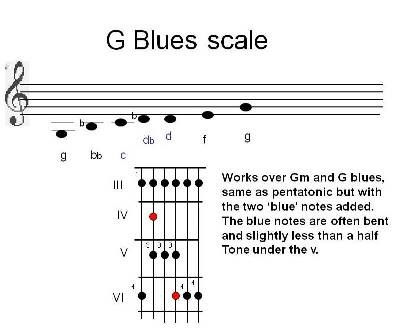Major and minor scales are the fundamental building blocks for other scales and modes that guitar players often find more interesting. The blues scale, the major and minor pentatonic scales are three guitar scales to practice beginner guitarists should know. That isn’t to say that you can ignore the major and minor scales. Those scales are the starting point for scales and modes guitar players find a bit more interesting. Learn those scales first and use them to build guitar scales beginner guitar players need to know.
Let’s start with the blues scale, shown below in the key of G. A G major scale contains the notes G-A-B-C-D-E-F#. The G blues scale omits the 2nd note, flats the third, raises the 4th (diminished or flatted 5th), and omits the 6th. A simpler way to look at the structure of the blues scale is by thinking of it as a minor pentatonic with the added raised 4th (B5th). This scale can be used to solo over all of the chords in the corresponding 12 bar blues progression.

The thing about the blues is that most guitar players try to think too much about it. Forget about traditional music theory when you play this scale. Understanding how it is built can be helpful, but the blues isn’t so much about the scale as it is about playing with the emotion of the blues. You can mechanically play this scale and not sound like you’re playing the blues, so don’t spend time stressing about which notes, think more about how to use them.
Check out this VIDEO GUITAR LESSON ON SCALES
The major and minor pentatonic scales are great rock guitar scales. They’re used in country music as well. To get a major pentatonic scale (a five note scale), simply remove the 4th and 7th degrees of the major scale and you have the pentatonic scale. To arrive at a minor pentatonic, use the 1st, 3rd, 4th, 5th, and 7th scale tones of the natural minor (which begins on the sixth note of a major key). This minor scale is also one of the seven common modes, the Aeolian.
These are guitar scales beginner guitarists will want to focus on right away. Getting them under your belt and distinguishing the variances in sound will help train your ear to their various applications and help give you an edge over players who struggle to know what to play and when to play it. One word of advice, though, there is no substitute for playing in real-life situations. Get familiar with these scales and where they are located on your fret board, but play them in real-life settings rather than as mechanical exercises. This will help make you a more versatile and fluid player.
If playing lead guitar is your goal, I recommend you to check out our:



